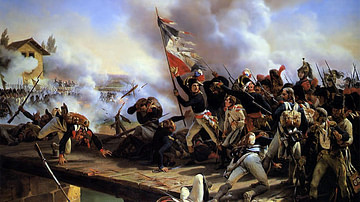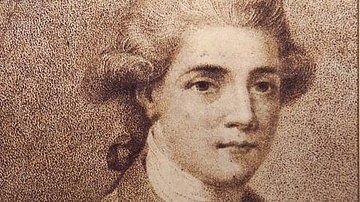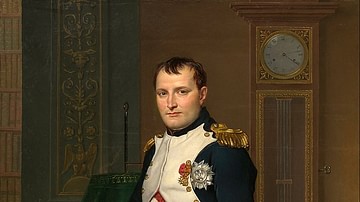The Battle of Castiglione (5 August 1796) was one of the most important battles of Napoleon's Italian Campaign of 1796-97. After laying siege to the vital fortress of Mantua, General Napoleon Bonaparte and his Army of Italy defeated an Austrian relief force at Castiglione. This victory allowed Bonaparte to resume the siege of Mantua and retain control of northern Italy.
Mantua was the key to Austria's control of northern Italy, making it imperative that the Austrians not allow it to fall into French hands. After Bonaparte first laid siege to Mantua in June 1796, the Austrians sent a 50,000-man army under Field Marshal Dagobert von Wurmser to relieve the city. Wurmser split his army into two corps, each moving down an opposite side of Lake Garda. This allowed Bonaparte to defeat the Austrian army piecemeal, at Lonato (3 August) and at Castiglione (5 August). While the Battle of Castiglione was significant because it prevented the Austrians from lifting the siege of Mantua, it also allowed Bonaparte to hone the techniques he would later use in future battles.
First Siege of Mantua
In June 1796, French General Napoleon Bonaparte was preparing to expel the Austrians from Italy. The 26-year-old Bonaparte had already won a name for himself; after whipping the demoralized and undersupplied Army of Italy back into shape, he had kicked the Kingdom of Piedmont-Sardinia out of the war in a matter of days. Then, after a daring cross over the Po River, he chased General Johann Beaulieu's Austrian army over the Adda, winning a memorable victory at the Battle of Lodi (10 May) before marching into Milan, the capital of Austrian Italy. As he laid siege to Milan's citadel where a small garrison of Austrians was holed up, Bonaparte reformed the city administration and installed a new constitution, while simultaneously securing millions of francs from the Milanese to pay his soldiers. After brutally suppressing rebellions in Pavia and Benasco, Bonaparte marched his army to the fortified city of Mantua which was the key to Austrian Italy.
Together with Peschiera, Legnago, and Verona, Mantua was one of the four fortresses that made up the famous Quadrilateral, which guarded the Alpine passes and the approaches to the Po and Lake Garda. Mantua itself was protected by three lakes to the north and east and by high, thick walls to the south and west and was defended by a garrison of 12,000 men and 316 guns. Bonaparte had thus far avoided getting bogged down in time-consuming sieges, but if he wanted to wrest control of Italy from the Austrians, Mantua had to be taken. After launching a failed surprise attack on the city on 31 May, Bonaparte left a division under General Jean-Mathieu-Philibert Sérurier to invest Mantua while he led the rest of his army south to browbeat the Papal States and the Grand Duchy of Tuscany into submission. This did not take long; Pope Pius VI asked for an armistice on 23 June, and several Tuscan cities opened their gates without a fight. Bonaparte secured several million francs as indemnities and requisitioned all their heavy guns before returning to concentrate his entire army around Mantua. On 29 June, the citadel of Milan finally capitulated, allowing Bonaparte to move the guns used in that siege to Mantua as well.

By 4 July, Bonaparte had 46,000 men and 179 guns outside the walls of Mantua. Sérurier's division of 10,500 men carried out the siege itself, supported by the divisions of Pierre Augereau, André Masséna, Pierre François Sauret, and Hyacinthe Despinoy, with cavalry reserves under General Charles Kilmaine stationed just south of Verona. Bonaparte was aware that each day he remained outside Mantua's walls was another day the Austrians had to reinforce themselves and was eager to bring the siege to a swift conclusion. Yet he was frustrated at every attempt to do so; for instance, General Joachim Murat's daring plan to infiltrate Mantua by leading a group of men disguised in Austrian uniforms over one of the lakes was foiled when the water level of the Po unexpectedly dropped. Time was running out; in late July Bonaparte received news that the Austrian army had regathered at Trento and was now bearing down upon him.
The Austrians Advance
Following the retreat from Lodi, General Beaulieu had been replaced by Field Marshal Count Dagobert von Wurmser, a septuagenarian veteran of the Seven Years' War (1756-1763). Fresh from the Rhine front, Wurmser arrived on 18 June to take the reins of the Austrian army at Trento, which now numbered around 50,000 men. After restoring a semblance of order to the demoralized army, Wurmser formulated a plan to relieve Mantua. He would divide his army into two separate corps: the first, commanded by Wurmser himself, would advance down the east side of Lake Garda with 32,000 men while the second corps, under Croatian-born General Peter von Quasdanovich, was to move down the west side with 18,000 troops. The plan was to scatter the French covering force and lift the siege of Mantua.
In late July, Bonaparte was apprised of Wurmser's plan by a paid informant on the Austrian staff. Leaving Sérurier to maintain the siege, Bonaparte arranged the rest of his 31,000 men to defend against the approaching army. General Sauret was sent to Salò with 4,400 men to slow Quasdanovich's advance, while General Despinoy and 4,700 troops were sent to guard the Peschiera-Verona line. Masséna led 15,000 men to the east side of Lake Garda to face Wurmser's main corps, and Augereau's 5,000 men were ordered to watch the eastern roads. Bonaparte himself traveled throughout the nearby towns to get a better handle on the unfolding situation; he apparently moved with such rapidity that he rode five horses to death in only a few days.
On 29 July, the Austrians encountered the French on both sides of Lake Garda. At 3 a.m., Masséna was confronted at La Corona and Rivoli by overwhelming Austrian numbers, and he was forced to make a fighting retreat to Bussolengo. "I have never seen the Austrians fight with such rage," Masséna wrote, "they were all drunk with brandy" (Chandler, 93). On the opposite side of the lake, Quasdanovich moved with more timidity but nevertheless succeeded in driving General Sauret out of Salò. The next day, Quasdanovich captured Brescia, a city that Bonaparte had assumed was far enough behind his lines to be safe; his wife, Joséphine de Beauharnais, had been in Brescia and only narrowly avoided capture, prompting Bonaparte to swear that Wurmser would "pay dearly for [her] tears" (Roberts, 110).
Bonaparte knew he had to defeat each Austrian force separately before they had the chance to combine. He decided to focus on Quasdanovich's corps first, since that was the weaker force. On 31 July, he ordered Sérurier to end the siege of Mantua and join the rest of the army; to avoid having the heavy siege guns fall into enemy hands, Sérurier was ordered to abandon all 179 guns and mortars and to dump what could not be moved into the lakes. The French divisions began to concentrate near Brescia, with Augereau's men marching 96 kilometers (60 mi) in only 55 hours to make it in time. General Bonaparte himself remained constantly on the move, which may have saved his life when he narrowly avoided being ambushed by a Croatian unit on the road from Roverbella. His sense of urgency was present in a letter he sent to General Masséna on 31 July: "Whatever happens, and however much it costs, we must sleep in Brescia tomorrow" (Roberts, 110).
Battle of Lonato
At 3 a.m. on 31 July, Sauret encountered an Austrian division under General Ott at Lonato. The two sides fought for hours until the arrival of Masséna's division caused Ott to withdraw and leave the town in French hands. This small triumph provided enough of an opening for Bonaparte to enter Brescia the next morning, at the head of Augereau's division. Wurmser, meanwhile, had reached the south end of Lake Garda; all he had to do was march west to link up with Quasdanovich and overwhelm Bonaparte's smaller army. But Wurmser was under the false assumption that Mantua was still under siege, leading him to march his corps south to the city's rescue. He arrived on 2 August only to discover that the French were nowhere to be found. He stopped to resupply Mantua's garrison before racing back toward Lake Garda, hoping to link with Quasdanovich before it was too late.
Wurmser's error afforded Bonaparte extra 24 hours and an opportunity he was not about to waste. Bonaparte sent Augereau to the town of Castiglione delle Stiviere to forestall Wurmser's advance for as long as possible, while the rest of his army dealt with Quasdanovich. On 3 August, the French engaged Quasdanovich's corps in a series of engagements collectively known as the Battle of Lonato. To the north, a single French brigade marched into the unoccupied town of Salò and captured the Austrian artillery park, while Quasdanovich held off three French attacks around Gavardo. Further to the south, the day's fighting reached its apex when an Austrian brigade forced its way into Lonato, routing the French brigade that was stationed there and capturing its commander.

Bonaparte personally arrived at Lonato just as Masséna was preparing a counterattack. After delivering a powerful speech, he organized the formidable 32nd demibrigade into "columns of platoons", ordered it to fix bayonets, and then hurled it against the Austrian brigade in Lonato. After brutal hand-to-hand fighting in which the French lost two battalion commanders, the 32nd succeeded in driving the Austrians out of Lonato and right into the path of Bonaparte's cavalry; Colonel Jean-Andoche Junot, despite having suffered six wounds, personally accepted the Austrian brigade's surrender. By nightfall, the frustrated Quasdanovich decided it was useless to try and push through Bonaparte's lines and ordered a retreat to the north. In a post-battle bulletin, Bonaparte delighted in the success of the 32nd, writing that the battle had been won because "the brave 32nd demi-brigade was there" (Roberts, 111). The 32nd proudly had those words embroidered on their flag.
Meanwhile at Castiglione, Augereau had succeeded in beating back Wurmser's corps after 16 hours of fighting. Augereau's efforts had prevented Wurmser from outflanking the French at Lonato; for years afterwards, whenever Augereau's loyalty was questioned, Bonaparte would respond, "Ah, but let us not forget that he saved us at Castiglione!" (Chandler, 94). On the morning of 4 August, as Quasdanovich's beaten corps prepared to make a northerly retreat, one confused Austrian brigade of 3,000 men wandered into Lonato, where Bonaparte had spent the night with only 1,200 men. Here, Bonaparte easily could have been captured. But the cunning French general parleyed with the Austrian commander and, with great confidence, told him that his "whole army" was present and if the Austrians did not lay down their arms in eight minutes the French 'would not spare a man" (Roberts, 112). The Austrian commander fell for the bluff and surrendered, learning he had been deceived only after his men had given up their arms.
Battle of Castiglione
Bonaparte turned his attention to Wurmser's corps, which he needed to soundly destroy before resuming the siege of Mantua. On 4 August, Bonaparte sent a small force to pursue the retreating Quasdanovich and ordered his remaining 31,000 men to concentrate against Wurmser, who was still at Castiglione. Wurmser commanded some 25,000 men; his right flank was anchored on the Solferino heights, and his left extended along a ridge with a forward detachment occupying the Monte Medolano hill, which was also protected by a heavy battery. As of the morning of 5 August, Bonaparte only had 20,000 men at Castiglione itself; Masséna commanded 10,000 men on his left, Augereau's 8,000 were drawn up in two lines in front of the town, and Kilmaine's cavalry was held in reserve. Bonaparte was banking on the arrival of reinforcements, as 5,000 men under General Despinoy were still marching from Brescia, and the 7,500 troops of Sérurier's division were coming from the south to hopefully strike the Austrians in the rear (Sérurier himself was ill, leaving command of his division to General Pascal Fiorella).

Bonaparte knew he needed to lure Wurmser away from his excellent defensive positions on the Solferino heights. To do this, he decided to open the battle with the risky, yet ancient, stratagem of feigning retreat. Early in the morning on 5 August, both Masséna's and Augereau's divisions were ordered to give ground; Wurmser, perhaps believing the French had lost their nerve, fell for the trap and sent his right flank forward, hoping to crush Masséna and open a road to Lonato, which he erroneously believed was still held by Quasdanovich. At 9 a.m., as the Austrian right flank was being drawn further from the heights, the sound of gunfire from behind Austrian lines alerted both sides to the arrival of Fiorella. Bonaparte ordered Masséna and Augereau to turn around and attack, while a cluster of grenadiers under Colonel Auguste de Marmont was sent to capture Monte Medolano on the Austrian left.
It was here where Bonaparte's plan began to unravel. Although Fiorella had indeed arrived at the head of Sérurier's division, he had begun his attack too early; Wurmser had yet to commit his reserves to the battle and was therefore able to hold off Fiorella while he pulled his right flank back to the heights. The divisions of Masséna and Augereau, which were supposed to pin down Wurmser's right flank, failed to do so, confused by the sudden order to attack after they had spent most of the morning retreating. An enraged General Bonaparte was forced to gallop up and down the lines to stir the men to action, lest Fiorella's division be completely overwhelmed, and the momentum lost. The French attack, when it finally came, was aided by General Despinoy, whose weary troops had just arrived from Brescia.

While the attack on the Austrian right flank had stalled, Colonel Marmont was proceeding with his assault on the left. He had brought up a battery of 18 guns, which bombarded Monte Medolano and cleared the way for a French assault. At 10 a.m., the French grenadiers launched an effective bayonet charge that drove the Austrians from the hill. Fighting raged along the Austrian line until Despinoy's 4th and 5th demibrigades stormed the castle at Solferino and forced the Austrians from the heights. The Austrians were now being squeezed on all sides. Fiorella's division still battled the Austrian reserves behind Wurmser's lines, and the French light cavalry swung around to attack the Austrian headquarters. Wurmser himself only narrowly avoided capture.
Shaken, Wurmser ordered a general retreat. Since Bonaparte's envelopment was not yet complete, Wurmser was able to escape, covered by his cavalry and by newly arrived reinforcements. The French tried to pursue, but, as Bonaparte reported in a letter to the French Directory, "our troops, worn out by fatigue, could only keep up the pursuit for three hours" (Chandler, 199). The Battle of Castiglione was undoubtedly a French victory; the French suffered around 1,100 casualties, while the Austrians had lost around 2,000 killed and wounded, with an additional 1,000 men and 20 cannons captured.
Aftermath
Although Bonaparte won the battle, he failed to annihilate Wurmser's army. Abandoning the battlefield of Castiglione, Wurmser withdrew across the Mincio River. He stopped only to engage the French in a minor skirmish at Peschiera and to reinforce and resupply the garrison of Mantua before retreating north toward Tyrol. On 7 August, the French occupied Verona, from where Bonaparte wrote to the French Directory that "the Austrian army…has disappeared like a dream and the Italy it threatened is now quiet" (Roberts, 113). On 10 August, Bonaparte resumed the siege of Mantua and spent the rest of the month refitting his army.
Wurmser may have been defeated, but he was not yet beaten. After regrouping at Tyrol, Wurmser made a second attempt to relieve the siege of Mantua; he was defeated on 8 September at the First Battle of Bassano. The remnants of Wurmser's army retreated into Mantua, where they were besieged along with the garrison; now overcrowded and running low on supplies, the garrison of Mantua continued to hold out until February 1797, when it surrendered after two additional Austrian attempts failed to relieve it.
Bonaparte's victory at Castiglione may have been less complete than he had hoped for, a failure that can mainly be attributed to the prematureness of the French attack. Yet he had succeeded in beating back the first Austrian attempt to relieve the siege of Mantua and had managed to retain control of northern Italy. Other aspects of the battle's significance are noted by historian David G. Chandler:
The form of the battle proves beyond any doubt that Napoleon's master battle plan was already clear in his mind as early as 1796. In subsequent years he might polish and improve its technique-especially the crucial matter of timing the successive stages-but all the elements of the successful attacks carried out at Austerlitz, Friedland, or Bautzen were already in existence and in operation at the battle of Castiglione. (201)
Castiglione contributed both to the success of Bonaparte's war in Italy and to his development as a military genius. It was a consequential moment for many nations of Europe, which would soon have to contend with Napoleon and the tactics he sharpened at Castiglione.









